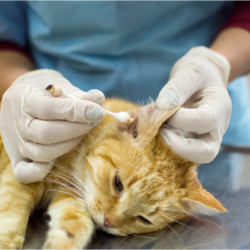Cat scratch disease, or feline regional lymphadenitis, is an infectious condition caused mainly by the bacterium Bartonella henselae. Although often considered a benign disease, it can lead to severe complications in immunocompromised individuals. The condition also represents a zoonotic risk, with documented cases of transmission of the bacteria to humans via scratches or bites from infected cats.
What bacterium is responsible?
Cats (both wild and domestic) can transmit diseases to humans, particularly through scratching or biting. A third of people who are scratched develop an infection. Cats’ claws carry many germs responsible for diseases such as cat scratch disease, pasteurellosis (bacteria) and sporotrichosis (fungus). These diseases are not contagious from human to human.
Cat scratch disease, also known as benign lymphoreticulosis or benign lymphogranuloma, is a bacterial infectious disease transmitted mainly by feline scratches. This zoonosis appears to be on the increase, or even emerging.
The disease is caused by two bacteria of the Bartonella genus:
- Bartonella henselae: a gram-negative bacterium of the bartonellaceae family. Its incubation period varies from 7 to 60 days when transmitted by cats. Stray cats can infect domestic cats via their fleas.
- Bartonella clarridgeiae (more rarely).
Bartonella henselae (or Rochalimaea henselae) is a gram-negative bacillus of the order Rhizobiales. This proteobacterium, responsible for cat scratch disease, is one of the most common bacteria. It infects host cells by attaching itself to their surface using self-transporting trimeric adhesins.
Present worldwide, the infection mainly affects domestic cats, especially kittens, although many are asymptomatic. Fleas transmit Bartonella bacteria between cats. Even a slight bite or scratch can infect people. Children often suffer the most serious consequences.
The bacteria are found mainly in the oral cavity of cats and are deposited on their fur and claws when they are groomed. It is not known where the micro-organism is located in cats; however, periods of asymptomatic bacteremia are cyclical. Fleas transmit the infection to cats and may also infect humans without direct contact with cats, although this hypothesis remains unproven.
Focus on fleas
Fleas belong to the order Siphonaptera, formerly known as Aphaniptera. They are holometabolous pterygote insects with mouthparts forming a biting-sucking apparatus. They are ectoparasitic and infest mammals (including humans) and some birds, feeding on the blood of their hosts. As they pass from one animal to another, they can transmit various animal, human or zoonotic diseases, and cause allergies.
Nearly 2,500 species of flea have been described, divided into 239 genera and 15 to 16 families, depending on the author, as well as 5 superfamilies.
Domestic cats are frequently infested by fleas. In Europe, the main flea species found in cats are Ctenocephalides felis (cat flea), Ctenocephalides canis, Pulex irritans and Archeopsylla erinace. Over 90% of infestations in domestic carnivores are due to the cat flea(Ctenocephalides felis).
Fleas go through four stages of development: egg, larva, pupa and adult. The length of the cycle depends on the species, temperature, humidity and availability of food.
If they cannot find a host, they reduce their metabolism and can survive for several months without food. A male flea absorbs 0.9 mm³ of blood per meal, and a female 1.4 mm³. Meals last from 2 to 5 minutes.
Fleas often infest hosts living in shelters (birds, rodents, carnivores, bats, humans). There are three types of contact: fur fleas, nesting fleas and sedentary fleas.
Flea bites cause occasional haemorrhaging and allergic reactions in humans. Fleas transmit diseases such as cat scratch disease(Bartonella henselae), a bacterial infection transmitted by cat scratches. This disease causes inflammation and can lead to complications in immunocompromised people.
What are the symptoms in cats?
In cats, the symptoms of bartonellosis can often go unnoticed and the animal generally tolerates the condition well. However, certain signs may appear:
- Visible flea infestation
- Fever
- Inflammatory reaction at the site of the bite
- Swollen lymph nodes
- Apathy
- Loss of appetite
- Inflammation of the mouth and/or eyes
- Nervous disorders (tremors, uncontrolled eye movements)
Females may also suffer from infertility or give birth to stillborn kittens. In all cases, consult a vet.
Vets do not systematically treat cats suffering from bartonellosis. Only cats presenting severe symptoms or carrying another chronic disease are given antibiotics. This is also the case for cats living with someone “at risk”, i.e. with a weakenedimmune system.
It is vital to keep a close eye on cats to detect signs of infection early and consult a vet for diagnosis and appropriate treatment.
How is this disease transmitted?
Cat scratches or bites mainly transmit cat scratch disease. More rarely, licking a wound or inoculating contaminated objects (thorns, splinters) can transmit it. Rubbing the eyes with contaminated hands or handling cultures in the laboratory can result in ocular transmission. Doctors also suspect flea bites as a transmission vector.
Little is known about the frequency of cases. The majority of infections occur in children and adolescents. Occupations at risk include :
- Breeders, salespeople, animal handlers
- Veterinary assistants, vets
- Veterinary laboratory staff
- Taxidermists
The disease is carried by Bartonella henselae, a bacterium mainly found in cats’ mouths. Cats deposit the bacteria on their fur and claws when they groom themselves. Children and adults under the age of 20, as well as immunocompromised individuals (cancer patients, HIV carriers, undergoing immunosuppressive treatment) are particularly vulnerable.
Modes of transmission include:
- Cat scratch or bite
- Licking a wound
- Flea bite
- Rubbing eyes with dirty hands
The first symptoms appear between three and ten days after infection. It is vital to monitor interactions with cats, especially for people at risk, and to consult a vet for advice on preventing flea infestations.
Cat scratch disease is easily transmitted to humans by scratching, biting or licking. Prevention involves good flea management and increased vigilance when in contact with cats.
What does the disease look like in humans?
Between 1 and 3 weeks after a cat scratch or bite, the following symptoms may appear:
- Redness of the skin at the site of the scratch, sometimes followed by a pustule and a crusty lesion.
- Appearance of hard, painful lymph nodes near the injured area:
- Under the armpit for a scratch on the hand or arm.
- In the groin for an injury to the leg.
- In the neck or behind the ears for an injury to the face.
- General symptoms: fatigue, low-grade fever, loss of appetite, headache, muscle or joint pain.
In the majority of cases, cat scratch disease heals spontaneously in 1 to 3 weeks without treatment. Nodes may persist for several months and develop into suppuration or fistula in some cases.
Infectious complications occur in 5-10% of cases and can affect all organs, in particular :
- Eyes: conjunctivitis with swollen eyelid and preauricular ganglion.
- Heart: endocarditis.
- Lungs: pneumonia (rare).
Serious symptoms include ocular, neurological and cardiac damage. Sometimes, a painless erythematous papule forms at the site of inoculation, accompanied by fever, headache, myalgia and weight loss.
Lymphadenopathy develops within 2 weeks, affecting a single lymph node in 60% of cases. The lymph nodes become fluctuating and may fistulate. In immunocompromised individuals (HIV, AIDS, immunosuppressive treatments), the infection can spread and be fatal without treatment. B. henselae, the bacterium responsible, is one of the main causes of culture-negative endocarditis.
How is the diagnosis made?
Diagnosis of cat scratch disease is based on clinical examination and serology. Serology involves testing for and measuring IgM antibodies to Bartonella henselae, with the positivity threshold varying according to the test used.
If there is any doubt, the germ’s DNA can be tested by PCR in a lymph node puncture or in the patient’s blood. A lymph node biopsy is used not only to search for the bacteria or its DNA, but also to carry out an anatomopathological analysis of the lymph node.
To diagnose the disease, the doctor may perform :
- Determination of circulating antibodies against the bacteria
- Blood culture to identify the bacteria in very ill or immunocompromised patients
- Aspiration or biopsy of lymphatic fluid for PCR analysis
PCR is used to amplify bacterial DNA, facilitating rapid detection of the bacteria. If the diagnosis is uncertain, especially if cancer is suspected, doctors take a biopsy of the swollen lymph node for histopathological analysis.
To confirm the diagnosis, doctors recommend serological tests in the acute and convalescence phases, at six-week intervals. They may also carry out PCR tests on lymph node samples.
Other infections, such as tularemia,mycobacterial infection, brucellosis,fungal infection and lymphogranulomatosis venereum, can cause similar lymphadenopathy. Examinations for these micro-organisms may be necessary if the diagnosis of cat scratch disease is uncertain.
In immunocompromised patients or those with systemic symptoms, prolonged blood cultures may be necessary. Lymph node punctures are rarely positive, but Bartonella spp can be isolated from lymph node biopsy cultures using special culture media.
How is this infection treated?
In general, after careful disinfection, cat scratches heal spontaneously without the need for medication, except possibly an analgesic for pain. In the usual forms of cat scratch disease, antibiotic treatment is not considered necessary for healing.
For more virulent forms, the doctor generally prescribes an antibiotic such as azithromycin. When the immune system is healthy, applying heat to the infected area and taking painkillers are usually sufficient. Antibiotics are sometimes administered to reduce swelling of the lymph nodes and prevent the spread of the disease.
Immunocompromised people, particularly those with HIV or AIDS, require antibiotics if the infection has spread. Antibiotics include ciprofloxacin, gentamicin and doxycycline, and must be taken for several weeks or even months.
The effectiveness of antibiotic treatment remains uncertain, and doctors generally do not administer antibiotics for localised infections in immunocompetent patients. However, doctors often prescribe azithromycin or doxycycline to reduce adenopathy and possibly reduce the risk of systemic spread. In the case of bacteremia in AIDS patients, they use a fluoroquinolone, rifampicin, gentamicin or doxycycline. Prolonged treatment is usually necessary to eradicate bacteraemia.
There is no vaccine, and the apparently benign nature of cat scratch disease does not mean that a few precautionary measures should not be taken:
- Avoid scratching or biting cats
- Avoid licking wounds by cats
- Disinfect wounds if bitten or scratched
- Wash your hands with soap and water after handling a cat
- Combating flea infestation in cats
What are the means of prevention?
Cat scratch disease is neither a contagious animal disease nor a notifiable human disease. It is not listed in the table of occupational diseases. Bartonella are classified in hazard group 2 (R. 231-61-1 of the French Labour Code).
For pets, regular flea treatment of cats and dogs and their environment is recommended.
For humans, the main measures include :
- Training and informing employees about the risks associated with the disease, hygiene and preventive measures.
- Handling and restraining animals.
- Implementation of appropriate means:
- Drinking water, soap, single-use wiping materials and first-aid kit.
- Separate lockers to prevent contamination of personal belongings.
- Appropriate, clean and well-maintained work clothes and personal protective equipment.
In general, the following are required
- Limit the risk of scratching and biting (proper restraint of animals).
- Respect hygiene rules.
- Do not rub your eyes after contact with animals.
- Always wash your hands (with soap and drinking water) after contact with animals, animal waste or excrement, and before meals, breaks and at the end of the working day.
- Do not eat, drink or smoke in the workplace.
- In the event of a wound, wash, soap, rinse, disinfect and cover with an impermeable dressing.
- Regularly clean work clothes, gloves and boots, and change clothes at the end of the working day.
If your cat scratches or bites you, disinfect the wound immediately. Teach your cat not to scratch, and check that your tetanus vaccination is up to date. To prevent the disease, it’s important to treat your pet for fleas with an anti-flea solution to ensure its health and well-being.





